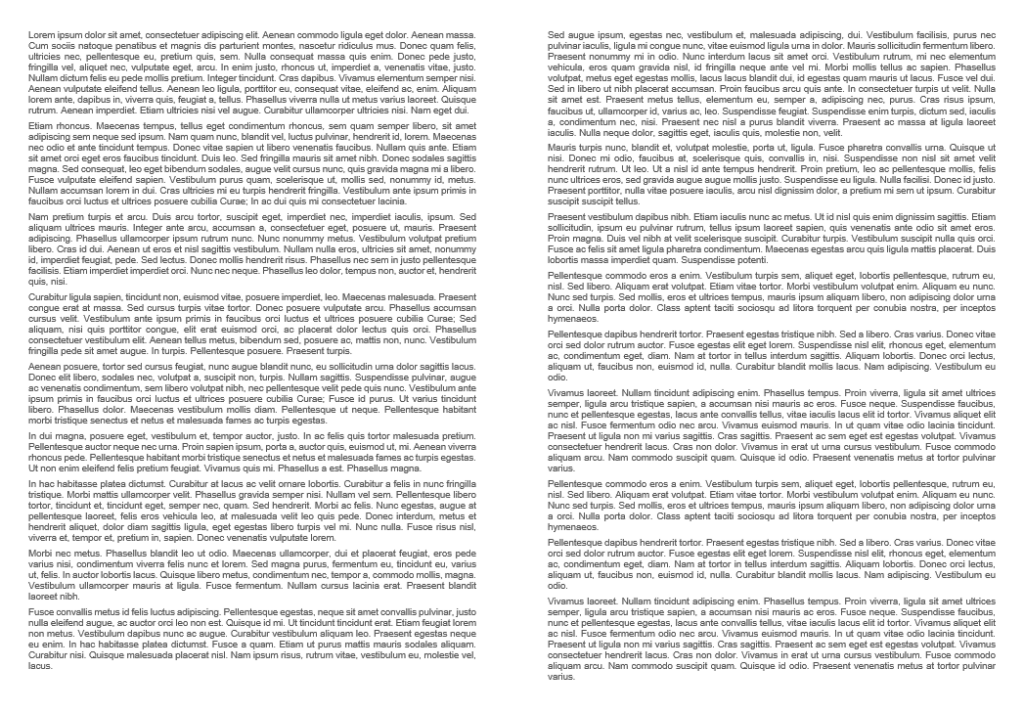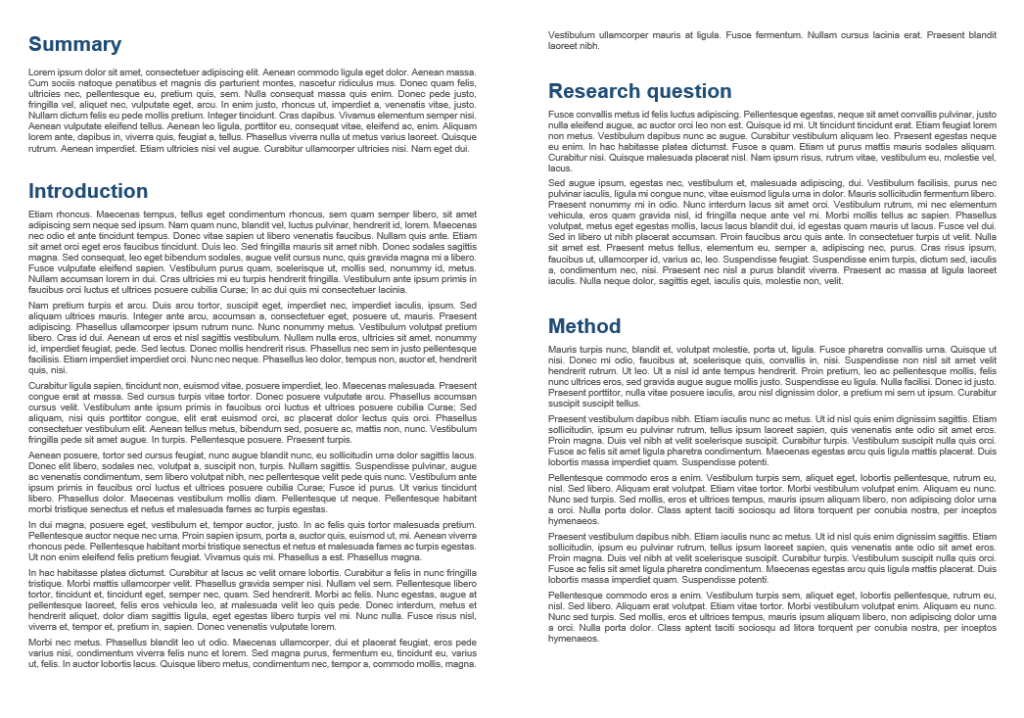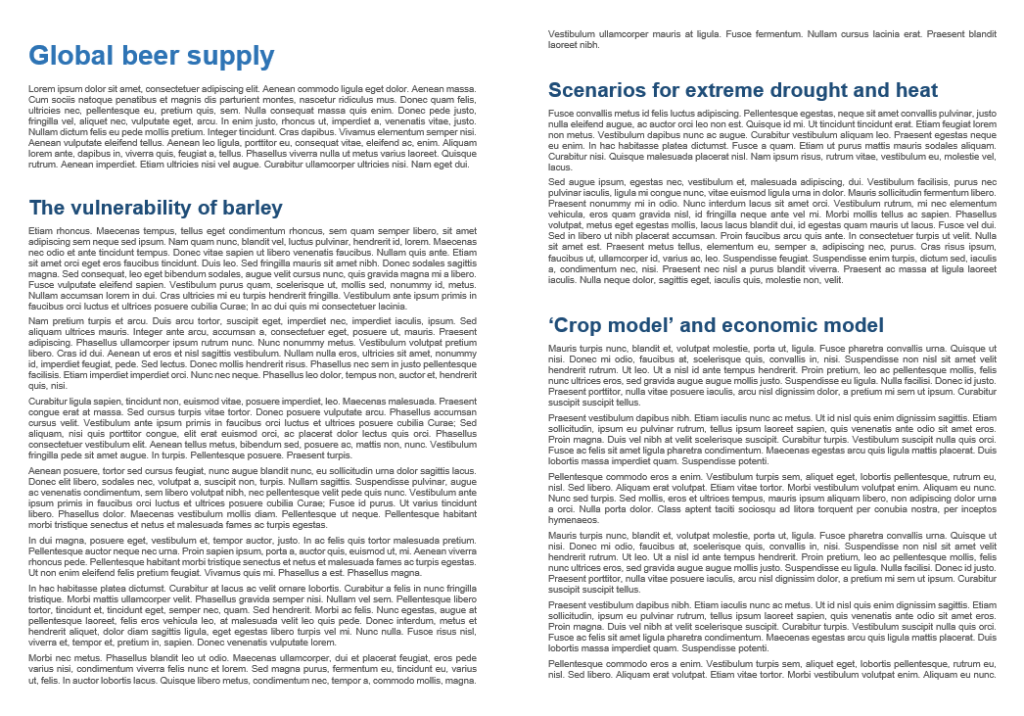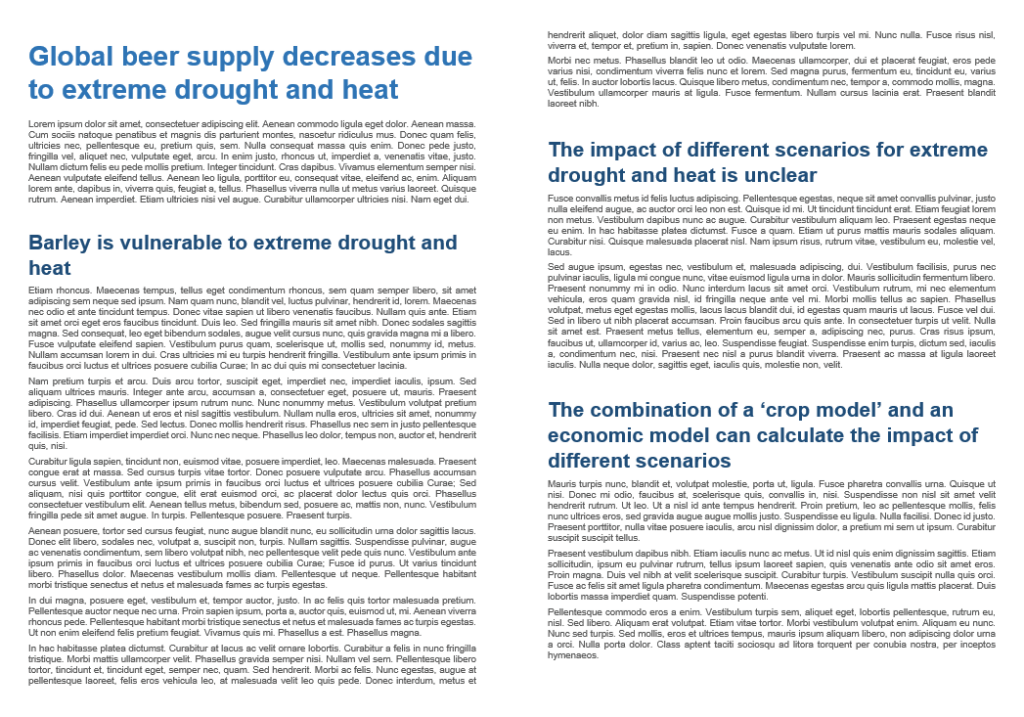Which heading do you prefer?
(1) ‘Global beer supply’ or (2) ‘Global beer supply decreases due to extreme drought and heat’?
Most people prefer heading number 2. It conveys more information, it’s more specific and more interesting.
Heading number 1 merely indicates the topic. Heading number 2 makes a statement about that topic. That’s why we call it a ‘statement heading’.
Do you communicate about a complex topic? Then it is good to use as many statement headings as possible.
You can use them on slides. As subheadings in a text. And also as titles for entire documents or presentations.
This article explains how statement headings work. And how to make them yourself – in 6 simple steps.
Statement headings help your audience understand your message
Headings are the most important sentences in communication. People construct these crucial sentences in various ways.
In communication about complex topics you’ll often encounter 4 types of headingsFor the sake of simplicity, ‘no heading’ will also be treated as a type of heading.:
- No heading
- A label heading, such as ‘Summary’
- A subject heading, such as ‘Global beer supply’
- A statement heading, such as ‘Global beer supply decreases due to extreme drought and heat’
Every one of these heading types provides more information than the previous one. Statement headings are the most informative.
Compared to a subject heading, a statement heading tells you what is going on with this subject. It communicates an idea about this subject. It declares, makes a statement.
It is effective to offer your audience as much information as possible right at the start – that is, in the heading. This way, your audience will better understand the message that follows, and it will understand it more quickly. It is also more likely to remember it.
Therefore, my advice is to use as many statement headings as possible.
The less informative types of heading are more common. Maybe you use them too.
In many disciplines, it is a custom to use these heading types. We are used to it. This is how almost everyone does it, this is how you learn to do it.
But for the audience, a heading with little information is not very pleasant.
3 types of headings you shouldn’t use too often
To show you why a statement heading works well, I will first briefly discuss the disadvantages of the 3 less informative types of heading.
No heading
Disadvantage: You offer your audience no clues
Luckily, documents without titles are rare.
But within documents and within presentations people don’t always use enough headings to help their audiences. For instance, you often see slides without headings.
Such a slide may look like this:
Without a heading, the audience has to decide for themselves – without any clues – what this slide wants to tell them.
This costs time and energy. And there’s a chance that they reach the wrong conclusion.
Informative texts often lack subheadings too. Such texts may look like this:

To a reader who wants to quickly look up something, these pages do not look very inviting.
People probably have to work hard to understand the message – that is, if they read the text at all. Beforehand, the audience has no idea what this text is about. Or where it can find the information it is looking for.
That’s why it is a bad idea to use no or very few headings.
Label heading
Disadvantage: Your audience still has no idea what this is about
Introduction. Conclusion. Summary.
You often find this type of subheadings in reports and scientific publications. They are called ‘label headings’.
When we add a label heading to the example slide, it looks like this:
The label heading is not very inspiring, and doesn’t make the audience much wiser. The big disadvantage is that a heading like this doesn’t tell you anything about the content.
That also applies to the text example:

Almost every reader scans the headings before she reads a text. In this case, a reader who does that has no idea what the text is about.
Of course, compared to the text without headings, the reader does have some extra information. She knows where a new part of the text starts. And what the status of that part is.
But compared to statement headings, the amount of information that a label heading conveys is small.
So, don’t use these headings out of habit, but only when it is compulsory. This is sometimes the case in a scientific paper, a report or a funding application.
Are you not obliged to use label headings? Then choose a more informative type of heading.
Subject heading
Disadvantage: Your audience has to wait for the conclusion
Headings that tell you what the subject is are called ‘descriptive headings’.
These headings are popular among knowledge workers too.
You see them above slides. As subheadings in texts. And as titles for entire documents and presentations.
With a subject heading, our slide example looks like this:
Compared to the previous versions this heading is very informative. The audience now understands right away what the data are about.
Still, there is something your audience doesn’t know:
What you want to tell them with these data.
Do you want to make the point that employees communicate less in open workspaces? Or that they communicate differently?
The audience has to take an extra step to interpret these data by themselves.
We can also put subject headings in a text, which would make it look like this:

A reader who has scanned the headings has some idea of the content.
But here, again, she doesn’t know anything about the message. What about these scenarios for extreme drought and heat?
Formulating the subject heading as a question doesn’t change much. A question heading (or ‘interrogative heading’) is about as informativeThe difference between a statement heading and a question heading is simple. A statement heading answers the question. as a subject heading.
For instance: What is the effect of open workspaces on communication?
So should you never use a subject heading (or a question heading)?
It is not that simple.
There are a couple of exceptions.
Possible reasons to choose a subject heading are:
- You have multiple messages. For this reason, titles of longer publications, such as books, often aren´t formulated as a statement.
- You want to discuss the data, so the main message is not clear yet.
- It is very important to make your readers curious (for instance, on social media). Sometimes a statement heading isn´t effective enough for that.
- Author instructions do not permit statement headings. This is the case with some scientific journals.
The trick is to use subject headings only when there is a good reason to do so.
In any case, try to get to a statement heading first. This is more often possible than you think.
If you can’t, you have at least thought about your message – and not just about your topic. Often, that helps focus your communication.
The type of heading that you should use as often as possible – statement heading
Advantage: Your audience better understands and remembers your message
A statement heading (also ‘declarative heading’) tells the audience the main message beforehand.
It can be the main message of an entire document (title). Or the message of a part of that document, like a slide or a text section (slide heading, subheading).
With a statement heading, our slide example looks like this:
The subject heading for this slide was: ‘Communication in open workspaces’. The statement heading specifies what is going on with this communication.
It is surprising that people communicate less in open workspaces. Open workspaces were designed to encourage communication.
When we add statement headings to the text example, it looks like this:

A reader scanning the headings reads a logical, flowing story. Compared to the version with subject headings, she has much more information.
That is why people understand text with statement headings better and more quickly.
There’s something else.
The statement headings in the examples are not only more informative, they are also more interesting.
A decrease in beer supply is more interesting than just ‘global beer supply’.
So, don’t worry that people will lose interest when you give away your main message (often the conclusion). Often, the main message prompts new questions.
Test in 1 minute whether you can spot the statement headings
Write down the numbers of all headings that you think are a statement heading
- Mortality in Puerto Rico after Hurricane Maria
- The Great Pacific Garbage Patch is rapidly accumulating plastic
- Association of Frequency of Organic Food Consumption With Cancer Risk
- Radar evidence found of subglacial liquid water on Mars
- Global warming transforms coral reef assemblages
- No intrinsic gender differences in children’s earliest numerical abilities
- Scientist on Twitter: Preaching to the choir or singing from the rooftops?
- Effect of Aspirin on Disability-free Survival in the Healthy Elderly
- Survey of Adélie penguin mega-colonies reveals the Danger Islands as a seabird hotspot
- The earliest modern humans outside Africa
Headings 2, 4, 5, 6 and 9 are statement headings. They state the main message of the article they belong to. The others are subject headings.
All these titles come from the Altmetric Top 100 2018, a list of the 100 scientific articles that were mentioned most online. I have made some minor adjustments to make the text more accessible.
Towards a good statement heading in 6 steps
You now know what a statement heading is (and isn’t). And you know why it is good to use statement headings.
But how do you make one yourself?
The step-by-step explanation below helps you. It consists of 6 simple steps:
Step 1: Think about your audience
Step 2: Know what you want to say (roughly)
Step 3: Choose at most 3 key terms
Step 4: Connect the key terms to make a sentence with a verb
Step 5: Make the heading more specific
Step 6: Remove redundant words
In the first 4 you formulate a statement heading. In step 5 and 6 you make little adjustments to optimize that heading.
Step 1: Think about your audience
Communication always starts with the audience. That is the starting point. This also applies to the statement heading.
That is because you may have a different message for different audiences.
So first, ask yourself what question your audience has about your topic.
A behavioral scientist, for instance, may wonder how open workspaces influence communication behavior.
A CEO probably has a more practical question: should I continue with open workspaces? In that case, the main message would be an advice rather than a conclusion.
Example: We formulate a heading for a behavioral scientist. We assume that she wants to know how open workspaces influence the communication behavior of employees.
Step 2: Know what you want to say (roughly)
With your audience in mind, you decide what you want to say. Your message, in broad strokes.
It is often a good idea to start with the subject. Or with the question that you want to answer.
But then you need to add another step.
‘I will show the data about communication in open workspaces’ is not enough. You have only a subject, and no message.
So ask yourself the question: what about it? What do you want to tell your audience with this data?
For instance, is this about the fact that people communicate less in open workspaces? Or that they communicate less face to face?
Example: Our message is that employees communicate less face to face in open workspaces. That is the most surprising result.
Knowing what it is (roughly) that you want to say, is the most important step on the way towards a statement heading.
This step is also the most difficult one. That is why it often takes a bit more time to make a statement heading compared to other heading types.
Step 3: Choose at most 3 key terms
In the next step, you write down key terms for your message. Usually, these are nouns.
If you know (roughly) what you want to say, key terms are usually easy to find.
It is ok to first write down a great number of terms. For instance: open workspace, traditional workspace, communication, interaction, collaboration, employees, face to face, email, WhatsApp and digital.
For your heading, you ultimately choose the 2 or 3 most important ones.
Just 1 key term will not get you an interesting message about a subject very quickly. With more than 3 key terms you risk ‘cramming’ multiple messages into your heading.
If you’re sure that you will stick to one main message, you can sometimes use more than 3 key terms.
Example: We choose the key terms open workspace, communication and face to face.
Step 4: Connect the key terms to make a sentence with a verb
In step 4 you connect the key terms to make a sentence.
To convey a message in your heading, you usually need a real sentence that is grammatically correct.
This is an important difference with the subject heading.
A subject heading with the key terms could be: ‘Open workspaces and face to face communication.’
A statement heading with these terms could be: ‘Open workspaces reduce the amount of face to face communication.’
The verb is the difference. It’s what is often added in this step.
Without a verb you don’t get a grammatically correct sentence. And the verb creates a relation between the key terms.
Example: Open workspaces reduce the amount of face to face communication.
Step 5: Make the heading more specific
You now have a statement heading. Such a heading is more informative than other heading types.
Still, you can often make your statement title even more informative.
Usually by adding more specific information
You can say, for instance, with what percentage face to face communication decreases. Or, to what kinds of open workspaces this applies, or what kinds of organizations.
Example: Open workspaces reduce the amount of face to face communication with 70%.
Sometimes, you can make the heading more specific by replacing a word.
Suppose we made the heading: Open workspaces change face to face communication. In that case ‘reduce’ would have been a more specific alternative.
Step 6: Remove redundant words
The more specific you make the heading, the longer it becomes.
Avoid making the heading too long. You have to find a good balance between being specific and concise.
A good heading consists of 5 to 15 words. This is a rule of thumb, and no absolute law.
If the heading is too long, your message gets buried in it. And a long heading also looks less inviting.
Whether your heading is long or short: it is always good to see if you can make it more compact.
You do this by deleting redundant words. Or by replacing word combinations with shorter alternatives.
Example: Open workspaces reduce the amount of face to face communication with 70%.
Invest time in making your headings
With these step-by-step instructions, you now know how to make good statement headings yourself.
You can use these headings in many places.
For publication titles. For chapters. As subheadings in a text.
But also as a title for a presentation, an infographic or a poster. Or as a subject line for an email.
Headings are the most important sentences in your communication. Good headings make sure that your audience understands you. And that it better remembers your main message.
So take your headings seriously, and take time and attention to make them. Give your communication a head start!

Arnaud is trainer, advisor and text writer at Analytic Storytelling. He helps customers to send out a clear and convincing message in both words and images.


